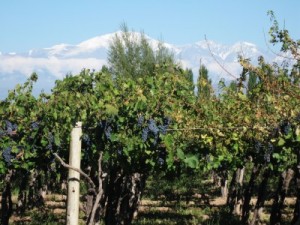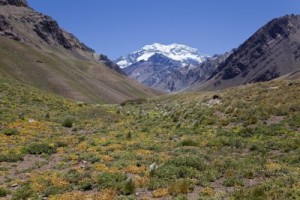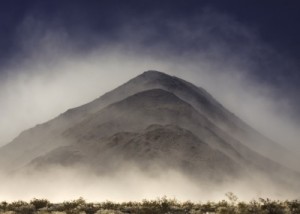T hey call it Huayrapuca, “the witches’ wind.” It sends birds flying, makes the sun appear brown, and knocks down trees. When they feel it approaching, people complain of sleeplessness, anxiety, a suffocating feeling, and depression. It usually starts up between noon and six pm, can last anywhere from one to 12 hours, and sounds eerily like a human whistling sound.
hey call it Huayrapuca, “the witches’ wind.” It sends birds flying, makes the sun appear brown, and knocks down trees. When they feel it approaching, people complain of sleeplessness, anxiety, a suffocating feeling, and depression. It usually starts up between noon and six pm, can last anywhere from one to 12 hours, and sounds eerily like a human whistling sound.
They also call it the Zonda wind, “viento Zonda.” Technically, the Zonda wind is a type of foehn wind, that is, a dry, down-slope wind that occurs on the lee (downwind) side of a mountain range. The Zonda is a regional term used for this type of wind as it occurs over those parts of western Argentina tucked into the slopes of the Andes, including the wine regions of Mendoza, La Rioja, and San Juan. The wind is especially brutal in these areas due to the high altitude of the mountain range it must climb over (and swoosh down.)
The Zonda forms as a result of humid air rising off the Pacific Ocean, where it travels up and over the Chilean side of the Andes. In the winter it helps the snow build-up in the high elevations of the Andes, which provides the much-needed melt-off (and the possibility of irrigation) to this otherwise arid area. The wind—as long as it stays somewhat moderate—can also help keep the vineyards dry, hygienic, and with a low level of risk from molds and fungi.
 In the spring and summer, however, the Zonda can create havoc as it descends down the Argentine side of the mountains. It loses its moisture, becomes warmer and warmer, and gathers up large clouds of dust. The Zonda generally rushes off the mountains at 25 miles per hour (40km/h) but can reach speeds of 120 miles per hour (~200 km/h). The Zonda can raise temperatures by as much as 54°F (30°C) in just a couple of hours; and the wind event is often followed by a freezing cold front. No wonder people go crazy!
In the spring and summer, however, the Zonda can create havoc as it descends down the Argentine side of the mountains. It loses its moisture, becomes warmer and warmer, and gathers up large clouds of dust. The Zonda generally rushes off the mountains at 25 miles per hour (40km/h) but can reach speeds of 120 miles per hour (~200 km/h). The Zonda can raise temperatures by as much as 54°F (30°C) in just a couple of hours; and the wind event is often followed by a freezing cold front. No wonder people go crazy!
While this unique weather phenomenon is a necessary part of the terroir of the region, it can also be disastrous to the vineyards. A Zonda in the spring can wind-burn a vine’s leaves and shoots or shake them right off the vine. The cold front that often follows the hot, dry wind can bring with it the risk of severe frost damage. For an interesting, short interview with a winemaker in his vineyard after a Zonda, click here.
The Legend of the Zonda
Legend holds that a Calchaqui Indian named Huampi was an arrogant hunter who spared no creature on his frequent hunting trips. He killed every creature in his path, from the tiniest wood birds to the majestic llama. His hunting prowess earned him great respect and he enjoyed being revered and even feared. However, his hunting was out of control to point that all of the region’s animals were on the brink of extinction.
 One day, as he was returning from the hunt, Pachamama, the earth goddess, appeared before him in a blinding light and said, “Humapi, villainous child of the earth! Do you intend to kill all the animals? Who will feed you when there is no meat, and who will clothe you when there is no wool?” And then, in a flash, she was gone.
One day, as he was returning from the hunt, Pachamama, the earth goddess, appeared before him in a blinding light and said, “Humapi, villainous child of the earth! Do you intend to kill all the animals? Who will feed you when there is no meat, and who will clothe you when there is no wool?” And then, in a flash, she was gone.
As Huampi slumped against a tree and tried to calm himself, he heard a strange whistling sound. He felt his face lashed and burnt by the wind. All around him, trees crashed to the ground, flowers and fruit swirled over his head, and he was blinded by the stinging dust in his eyes. Pachamama’s revenge was upon him, and since that day, as the Zonda screeches through the Andean valleys, it cries out with a human voice, causing all in its path to stop and pay respect to the power of mother earth.
For more information on “the winds of wine,” see our posts on The Mistral and The Roaring 40’s.
Post written by Jane A. Nickles, CWE (your SWE Blog Administrator)
Love this information! I actually once experienced the Zonda…it was wild!
Thanks for this great new wine blog. I love the vignettes and stories on the history of wine.
Pingback: The Winds of Wine: The Roaring 40′s - Wine, Wit, and Wisdom
Pingback: The Winds of Wine: Le Mistral - Wine, Wit, and Wisdom
cool story!